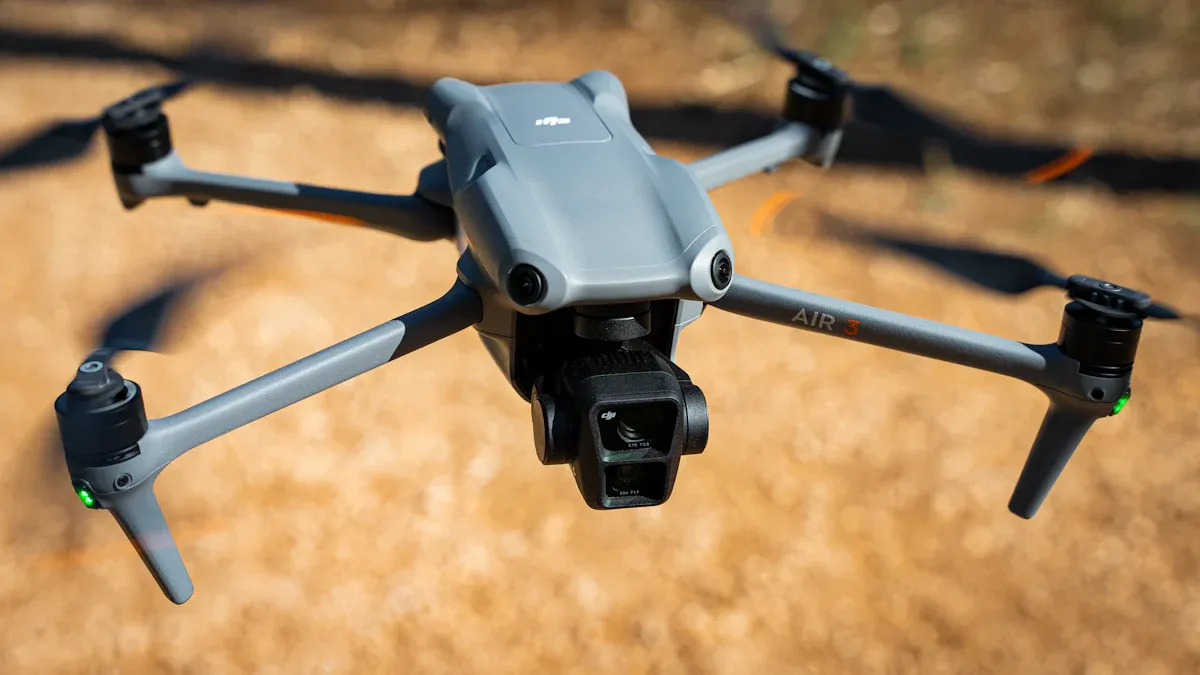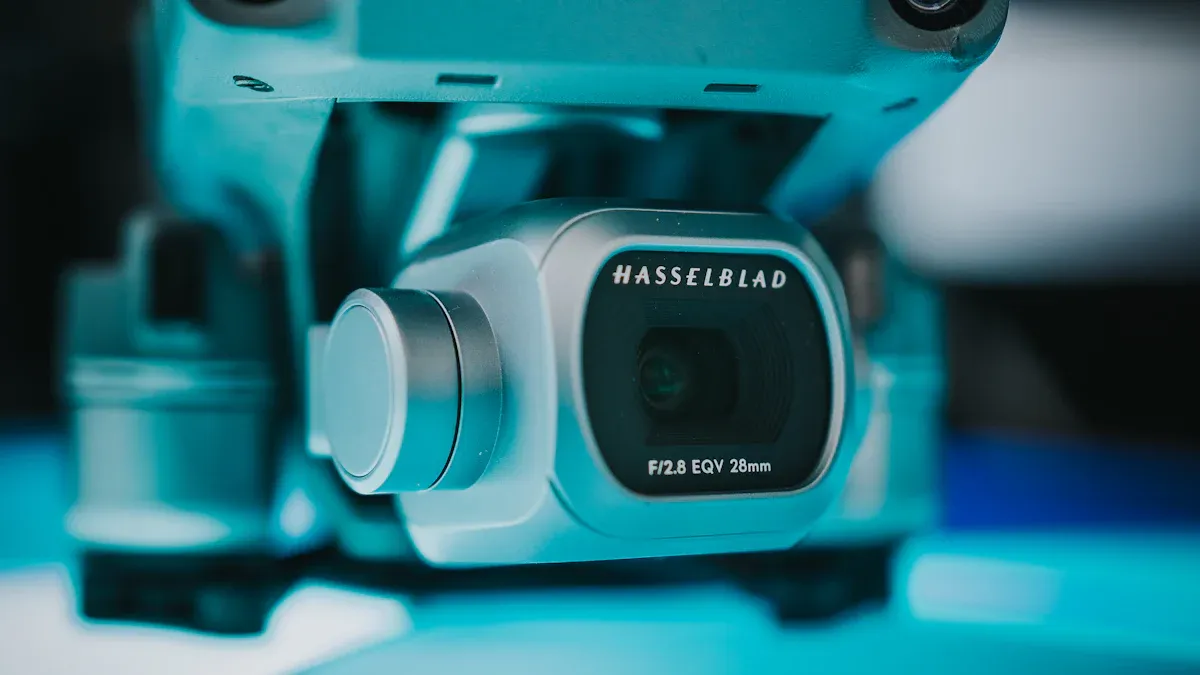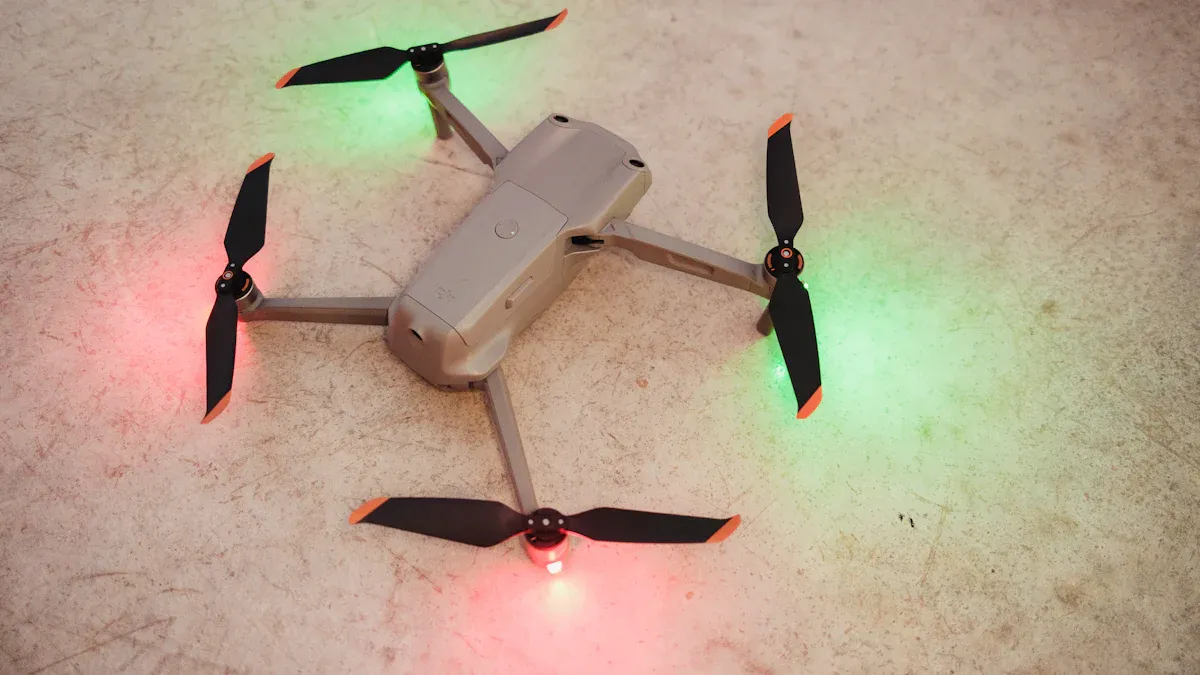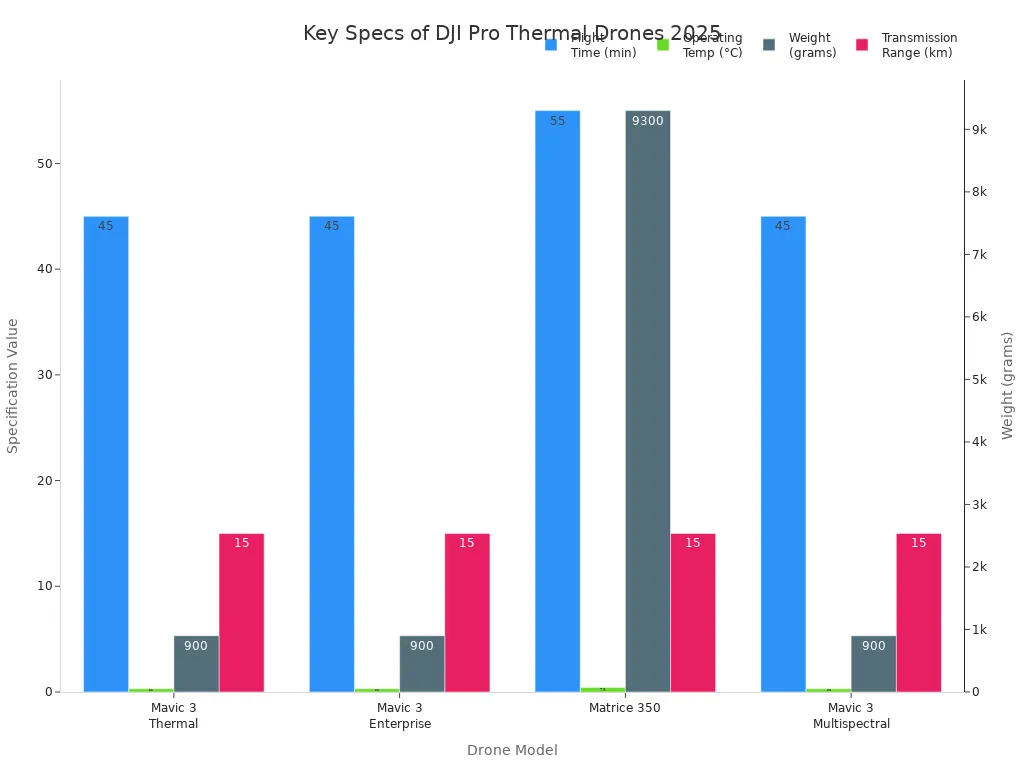
If you want the best thermal drones for work, look at the DJI Mavic 3 Thermal, DJI Matrice 30T, DJI Matrice 350 RTK with Zenmuse H20T, and DJI Matrice 4T. Each dji thermal camera has a high-quality sensor, strong zoom, and dual-sensor thermal imaging. Many jobs now need the right thermal drones. In 2020, inspection and maintenance were 35% of drone service work. This shows that many workers use the best thermal drones and camera drone options. You need a dji thermal camera with great image quality, long flight time, and simple controls. Picking the newest thermal drones or thermal imaging drones makes your job safer and easier.
Key Takeaways
DJI thermal drones give clear pictures, fly for a long time, and are simple to use. These features help workers stay safe and finish jobs faster. High-quality sensors and dual or triple camera systems show heat and normal views at the same time. This helps with better inspections and rescue work. Long battery life and smart features like hot-swappable batteries and AI tracking mean less waiting and more work done. Pick a drone that matches your job, like fast setup for emergencies or high-resolution cameras for close checks. Buying advanced DJI thermal drones saves time, keeps people safe, and gets your team ready for future problems.
Key Criteria
Image Quality
When picking thermal drones for work, image quality is very important. A high-resolution thermal camera gives clear and detailed pictures. This helps even when the weather is bad. Jobs like search and rescue, firefighting, or checking buildings need good images. Good thermal imaging lets you find problems quickly, like hidden fires or broken equipment. If your drone gives sharp images, you can make better choices and keep your team safe.
Tip: Always clean and check your drone’s sensors. This keeps your thermal camera working well and your results correct.
Scenario | Role of Image Quality and Features | Result/Benefit |
|---|---|---|
Firefighting | High sensitivity, color palettes, and clarity help see through smoke | Find hidden fires, map disasters, and get a better view |
Search and Rescue (SAR) | Thermal clarity and isotherms help find people in hard conditions | Search faster, help more people, and cover big areas quickly |
Industrial Inspection | High resolution finds problems in hard-to-reach places | Spot risks early, fix things sooner, and watch sites better |
Sensor Resolution
Thermal camera resolution is very important for professionals. Most thermal drones have sensors with 640 × 512 pixels. This is the normal amount for the industry. Some top models, like the Zenmuse H30T, have up to 1280 × 1024 pixels. Higher thermal camera resolution shows more details and helps you see small problems from far away. This is needed for jobs where you must find tiny heat changes or check big areas.
Flight Time
Long flight time helps your thermal drones work better. You can check bigger places and finish jobs faster. Some drones, like the DJI Matrice 350 RTK, can fly for 55 minutes. Others, like the Matrice 4T, can fly about 40 minutes with a full load. This means you do not need to change batteries as much. You also spend less time waiting. In emergencies, longer flight time lets you keep searching or checking without stopping.
You finish more work in one flight.
You save time and money on each job.
Your team is safer with fewer takeoffs and landings.
Ease of Use
You want thermal drones that are simple to use, even for new users. Fast setup, foldable bodies, and smart things like hot-swappable batteries help a lot. With easy apps like DJI Pilot 2, you can fly your drone and use thermal imaging with a few taps. Features like AR pins, smart tracking, and weather resistance help you work faster and with less worry.
Quick setup means you can start urgent jobs faster.
Simple controls mean your team learns quickly.
Smart features help you focus on the job, not the drone.
Best DJI Thermal Camera Features

Dual-Sensor Systems
When you use a drone with two cameras, you get both thermal and normal video at once. This lets you see heat and regular pictures together. Many workers use dual-sensor systems for search and rescue, firefighting, police work, and checking buildings. These features help you find heat spots, locate people, and check equipment from far away.
Dual camera systems let you switch between thermal and normal views.
You can compare both images side by side for better results.
Dual cameras help you watch things live and keep your team safe.
With FLIR MSX, you can put thermal images over normal ones for clearer pictures.
Some DJI drones have a triple camera system. You can use thermal, wide, and zoom cameras for close checks and thermal photos.
Zoom Capabilities
Zoom is very helpful for professional jobs. With two cameras, you can zoom in on both thermal and normal video. The DJI Mavic 3 Thermal can zoom up to 56×. This helps you see small things from far away, which is good for checks or watching places.
Triple camera drones let you switch between wide, zoom, and thermal views. You can find small problems without getting close. In firefighting, zoom helps you see hot spots through smoke. In police work, you can watch from far away without being seen. These features make your job safer and easier.
Temperature Sensitivity
High thermal sensitivity is very important in thermal imaging. It shows how well your drone finds small temperature changes. A lower NEDT means better and more correct results.
Feature/Aspect | Details/Significance |
|---|---|
≤50 mK, so you can spot even tiny temperature differences | |
Heat Signature Detection | Find people, animals, or overheating equipment fast |
Multi-Sensor Fusion | Mix thermal, RGB, and NIR data for better target recognition |
AI-Driven Thermal Tracking | Lock onto people or hotspots using smart pattern recognition |
Use in Firefighting | See hotspots through smoke and flames, helping with rescue and resource placement |
Use in Electrical Inspections | Catch overheating parts early, stopping failures before they happen |
With these thermal imaging features, you can trust your drone to do a great job every time. Whether you need thermal photos, dual-camera views, or a triple camera, DJI gives you what you need to work smarter and safer.
Best Thermal Drones for Professionals
DJI Mavic 3 Thermal
The DJI Mavic 3 Thermal is a small but strong dji thermal camera. It is easy to carry in a backpack. You can set it up in less than two minutes. This is great for teams who need to move fast in emergencies. The drone has a dual camera system with both thermal and optical sensors. You can use split-screen zoom to see both thermal and normal images at the same time. This helps you find problems quickly during search and rescue or firefighting. The drone also has advanced flight modes, like waypoint navigation. This lets you plan missions for checking buildings or land.
Specification | Details |
|---|---|
Cameras | |
Zoom | 56x hybrid zoom (wide), 28x digital zoom (tele) |
Thermal Imaging Features | Spot/surface temperature, alerts, color palettes, isotherms |
Flight Time | |
Max Speed | 19 m/s |
Max Takeoff Altitude | 6000 m |
Controller Screen | 1000-nit brightness |
Battery Charging | 100W Fast Charging Hub |
Price | $4999 (Standard Version) |
You can watch projects live and make smart choices. The drone flies for a long time and sends images clearly. It is small, foldable, and simple to use. It has sensors all around to help avoid crashes.
Pros:
You can watch projects live and make smart choices.
The drone flies for a long time and sends images clearly.
It is small, foldable, and simple to use.
It has sensors all around to help avoid crashes.
Cons:
Some features cost extra each year.
The gimbal may not always work perfectly.
Some places have rules about drone weight.
Note: Many people use the Mavic 3 Thermal for search-and-rescue, checking buildings, and watching wildlife. You can trust its camera and that it works well, even in bad weather.
Ideal Use Cases:
Search and rescue missions
Firefighting and disaster response
Building and infrastructure inspection
Public safety patrols
DJI Matrice 30T
The DJI Matrice 30T is tough and ready for hard jobs. It has three cameras: a 48MP zoom, a wide-angle, and a thermal camera. There is also a laser rangefinder to measure distance. The drone folds up but is bigger than the Mavic 3 Thermal.
Key Features:
640p thermal camera with super-resolution and temperature alarms
Laser rangefinder for accurate distance measurement
Up to 41 minutes of flight time
IP55 weather resistance for all-weather use
Hot-swappable batteries for continuous operation
Advanced software integration with DJI FlightHub 2 and DJI Dock
You control the Matrice 30T with the DJI RC Plus remote and DJI Pilot 2 app. The controls are easy, even for new pilots. The drone can fly in special patterns and record from all four cameras at once. This makes it great for checking things, search and rescue, and watching the environment.
Pros:
You can set it up fast and carry it easily.
It is strong and works in rough places.
It sends video far and keeps it steady.
It has many sensors for clear pictures.
Cons:
It is heavier and harder to carry than smaller drones.
It costs more than basic models.
Tip: If you work in public safety or check big areas, the Matrice 30T has what you need to finish the job fast and safely.
Ideal Use Cases:
Search-and-rescue operations
Firefighting in tough weather
Infrastructure and utility inspection
Environmental monitoring
DJI Matrice 350 RTK + Zenmuse H20T
The DJI Matrice 350 RTK with Zenmuse H20T is for the most advanced jobs. This drone can carry up to three tools at once, including the strong H20T sensor. You get a zoom camera, a wide camera, a high-res thermal camera, and a laser rangefinder all together.
Advantages | Details |
|---|---|
RTK Positioning | Centimeter-level accuracy for mapping and surveying |
Payload System | Multi-sensor, supports up to 2.7 kg, including Zenmuse H20T |
Transmission | OcuSync Enterprise, up to 15 km range |
Durability | IP55 rating, works in -20°C to 50°C |
Obstacle Avoidance | Six-directional sensing, CSM Radar option |
Flight Time | Up to 55 minutes (varies with payload) |
AI Features | PinPoint, cloud-based mapping, intelligent flight modes |
Expansion | Customizable ports for extra accessories |
Limitations:
It costs a lot (over $9,200 without batteries).
It is heavy (almost 4 kg without batteries).
The flight time is shorter if you carry more tools.
It takes longer to charge.
You can use this drone for search-and-rescue, firefighting, and checking big buildings. The RTK system helps you make very accurate maps. Teams like the hot-swappable batteries because you do not have to stop to recharge.
Ideal Use Cases:
Search and rescue in large or hazardous areas
Firefighting in extreme conditions
Utility and infrastructure inspection
Law enforcement surveillance
Detailed mapping and surveying
Callout: The Matrice 350 RTK + Zenmuse H20T is great for important missions. You get good data, long flights, and can add things like speakers or lights for emergencies.
DJI Matrice 4T
The DJI Matrice 4T is a new, high-res thermal drone for hard jobs. It has many cameras: a wide-angle, a medium telephoto, a 112x hybrid zoom telephoto, and a high-res thermal camera (1280 x 1024 pixels). There is also a laser rangefinder that works up to 1,800 meters.
Main Features:
Multi-sensor: wide, telephoto, and thermal cameras
1280 x 1024 high-res thermal camera for detailed heat detection
112x hybrid zoom for close-up inspections
Laser rangefinder for precise measurements
Near-infrared light for night and low-light operations
Up to 48 minutes of flight time (without payload)
Advanced AI automation: Smart Track, Point of Interest, FlyTo
Enhanced obstacle detection and Vision Assisted Return-to-Home
Local Data Mode for data security
The Matrice 4T is bigger and heavier than the Mavic 3 Thermal. It takes about 5–10 minutes to set up and needs a flat place to launch. It is not as easy to carry, but it is much stronger for hard missions. You can use it for search-and-rescue, firefighting, and checking buildings, especially when you need to see through smoke or darkness.
Pros:
The thermal camera gives clear, detailed images.
AI helps you finish missions faster.
It is strong and works well in bad weather.
It can send video over 20 km away.
Cons:
It takes longer to get ready than small drones.
You need two people to use it best.
Note: The Matrice 4T is best when you need top features for important missions. Teams trust it for its strong cameras and night vision.
Ideal Use Cases:
Search and rescue in low visibility
Firefighting with thermal and visual imaging
Infrastructure inspection from a safe distance
Mapping and 3D modeling for construction
Comparing Size, Deployment, and Industry Fit
Mavic 3 Thermal: Smallest and fastest to use, best for quick search and rescue or patrols.
Matrice 30T: Easy to carry but tough, mixes speed and strong features, good for public safety and checking things.
Matrice 350 RTK + H20T: Can carry the most and fly the longest, best for big checks, mapping, and hard emergency jobs.
Matrice 4T: Has the best cameras, takes longer to set up, great for high-res thermal images and tough missions.
If you want the best thermal drones for your work, think about what you need, how fast you must start, and which features help you most. Each of these thermal imaging drones has special strengths to help you work better and safer.
Thermal Drones Comparison

Specs Table
When you compare thermal drones, you want to see the main specs side by side. This helps you pick the right one for your work. Here’s a quick look at the top models for 2025:
Model | Camera & Features | Flight Time | Weight | Temp Range | Special Features |
|---|---|---|---|---|---|
DJI Mavic 3 Thermal | 48MP wide, 12MP tele (56x zoom), 640×512 thermal | 45 min | 900g | -10°C to 40°C | Thermal imaging, high temp alerts, color palettes |
DJI Matrice 30T | 48MP zoom, wide, 640p thermal, laser rangefinder | 41 min | 3.7kg | -20°C to 50°C | IP55, hot-swap batteries, advanced AI |
DJI Matrice 350 RTK + H20T | Multi-payload, high-res thermal, laser rangefinder | 55 min | 9.3kg | -20°C to 50°C | RTK mapping, weather resistance, payload support |
DJI Matrice 4T | Wide, tele, 1280×1024 thermal, 112x zoom, laser | 48 min | 4.5kg | -20°C to 50°C | AI automation, night vision, long-range video |

Feature Highlights
You might wonder which thermal drones fit your job best. Each model stands out for different reasons:
Mavic 3 Thermal gives you a compact size and fast setup. You get strong thermal imaging and long flight time. This is great for law enforcement or quick inspections.
Matrice 30T brings you more power and weather resistance. You can use it in tough places and get advanced AI features. It works well for public safety and big area checks.
Matrice 350 RTK + H20T offers the longest flight time and the most payload options. You can use it for heavy-duty jobs like infrastructure inspection or mapping large sites.
Matrice 4T shines with its high-res thermal camera and smart automation. You get clear images even at night. This model fits search and rescue or any mission where you need top-level detail.
If you need portability, go with the Mavic 3 Thermal. For the toughest jobs, the Matrice 350 RTK or Matrice 4T will not let you down. Always match the features to your real-world needs. The right choice helps you work faster, safer, and smarter.
Choosing the Right Model
Application Needs
You should pick a thermal drone that fits your job. Different jobs need different things. Search and rescue teams need drones that set up fast. They also need clear thermal images. Emergency teams work in bad weather, so weatherproof drones help them. If you work in energy or farming, you need long flights and sharp sensors. This helps check big fields or power lines.
Here’s a simple table to compare features for each job:
Feature / Model | Mavic 2 Enterprise Advanced | Matrice 30T |
|---|---|---|
Thermal Imaging | High-res radiometric | Wide-angle thermal |
Zoom Capability | 32x digital | 16x optical, 200x hybrid |
Flight Time | Up to 31 min | Similar, quick setup |
Weather Resistance | Not specified | Weatherproof (IP55) |
Industry Fit | Firefighting, inspection, law enforcement | Emergency response, search and rescue |
If you need to search big areas, pick drones with three cameras. You also want long battery life and good obstacle sensors. In farming, multispectral sensors help find crop problems fast. For energy jobs, you need RTK and a tough drone body.
Budget Considerations
You want a drone that gives you the most for your money. Some drones cost more because they have two cameras, fly longer, and have extra safety. These features help you finish rescue jobs faster and safer.
High-res thermal cameras and long-range signals are worth it.
Sensors all around help keep your team safe.
Built-in software makes planning and checking data easy.
Benefit Description | Long-Term Value | |
|---|---|---|
Camera Quality | Sharp images for inspections | Accurate data, fewer mistakes |
Flight Performance | Longer flights, better wind resistance | More work done per mission |
Build Quality | Strong materials, fewer repairs needed | Lower replacement costs |
Tip: Paying more at first for a good drone can save money later. You get fewer problems and better results.
Future-Proofing
You want your drone to stay useful for a long time. Look for drones you can upgrade with new cameras or sensors. AI features and fast takeoff are now common.
DJI keeps adding smart tools like real-time problem finding and better automation. You should also think about rules and keeping your data safe. Some jobs need NDAA-compliant drones or strong data privacy.
Aspect | What to Check For |
|---|---|
Regulations | Meets local and industry rules |
Environmental Fit | Works in harsh weather, wide temp range |
Tech Trends | AI, high-res thermal, modular payloads |
Investment Strategy | Scalable, secure, and ready for future upgrades |
Note: If you plan for new rules and tech, your drone will keep working as your business grows.
If you pick a DJI thermal camera in 2025, you get clear pictures, long flying time, and smart AI tools. These cameras help you stay safe and finish work faster in jobs like search and rescue or checking buildings.
Make sure the camera’s features fit what you need and how much you can spend.
Also, think about new upgrades, better technology, and how your team will use the camera.
Picking the right camera helps your business do well now and be ready for new problems later.
FAQ
What industries benefit most from DJI thermal cameras?
You will see the biggest benefits in public safety, utilities, construction, and agriculture. These cameras help you spot problems fast, keep teams safe, and save time on inspections.
How do I choose between the Mavic 3 Thermal and Matrice models?
Think about your job size and speed. If you need quick setup and easy travel, pick the Mavic 3 Thermal. For bigger sites or tougher jobs, Matrice models give you more power and features.
Can I use DJI thermal cameras in bad weather?
Yes, you can. Models like the Matrice 30T and 350 RTK work in rain, wind, and cold. Always check the weather rating before you fly.
Are DJI thermal cameras hard to learn?
No, you will find them easy to use. DJI apps have simple controls. Most teams learn the basics in one day.
Do I need special training to use a thermal drone for inspections?
You do not need a license for the camera, but you may need one to fly. Check your local rules. Many companies offer quick training for safe and legal use.
See Also
The Importance Of Thermal Imaging Cameras In 2025
Using Thermal Imaging Cameras For Search And Rescue Missions
Vanadium Oxide Thermal Cameras Enhancing Rescue Operations
